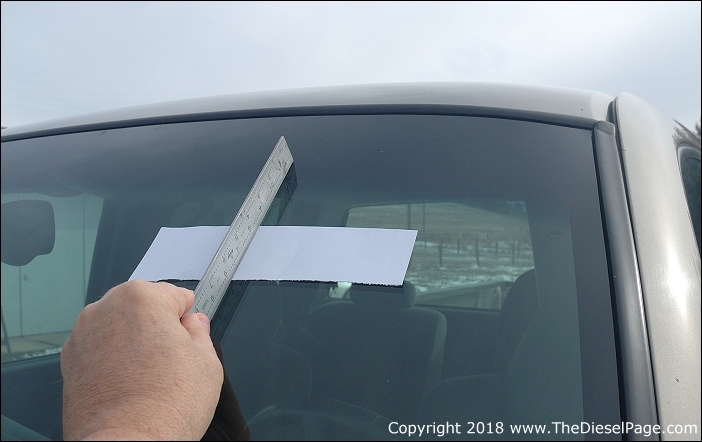|
What you need to know before replacing a cracked windshield or any other piece of automotive glass. We're here to save you money and provide the information you need to be 100% satisfied with the replacement.  I had my truck's windshield replaced recently by a nationally known auto glass replacement company. I asked the manager about brands of glass before scheduling an appointment, and was told that they only install "OEM quality glass that was used by many auto manufacturers". Sounded impressive, so I handed him my keys. You see, even though they advertise a mobile service, meaning they'll come to you, I went to them because I wanted the installer to have all the time and every piece of equipment he needed to do a perfect job. All went well, and I even had them install a new set of their best mono-blade wipers, that were just like the old blades I had on at the time. When I picked up the truck I was satisfied with both the appearance of the new windshield and its installation. I was impressed. However... I noticed a day or two later that there was an area measuring about 2-1/2" by 5" that the new mono-blade wiper was skipping on the driver's side of the windshield. Unfortunately, the skipped area was in the driver's primary viewing area (see lead-in photo) - the worst possible location. I thought it might be due to the new mono-blade wipers, and hoped they would level-out over time. How could there possibly be a problem with a brand new "OEM Quality" windshield replacement? I then forgot about it because we didn't have any rain for a couple of months. Later that summer a cold front moved through our area that produced some light showers.... and I needed to drive in the rain and road spray. The same spot on the windshield that I had identified months earlier had become a serious safety issue. When I got home, I put a straightedge on that section of glass, and discovered a low spot - something I've never seen before on a windshield. Trading wiper blades side for side didn't change a thing. For those who haven't thought about it, the surface of the GM pickup truck windshield is mostly a compound curve that bows outward. A straightedge should rock nearly anywhere you place it. The lead-in photo shown above shows where the low spot was located - right in the middle of the driver's vision. The depth of the dip was actually several times the thickness of a sheet of 24# paper. Once the area on the windshield had been identified, you could also see an optical aberration in that location. The company that replaced the windshield offers a "Lifetime Replacement" warranty for material defects or workmanship. Before I called the shop I did a little online research into the glass manufacturer logo that was on the bad windshield. Turns out, the windshield was imported. I've been really disappointed by a variety of imported automotive products in recent years. This just reinforced my disappointment. After a short phone call to the local auto glass installer, I was asked to return the truck to them for inspection. I did. I also took a strip of paper and a straightedge with me to show the manager what the problem was. He was somewhat startled and noticeably agitated when I placed the paper strip and straightedge on the windshield - on a public street adjacent to his auto glass business. I guess I didn't consider what a passing motorist might think. Thinking this problem was limited to just this one windshield, the shop owner offered to install a second one - same imported brand. Turned out, this one had the exact same problem. The equipment used to form this windshield must have been defective. I couldn't help but wonder how many other 1999-2007 GM pickup windshields had been produced by this company. 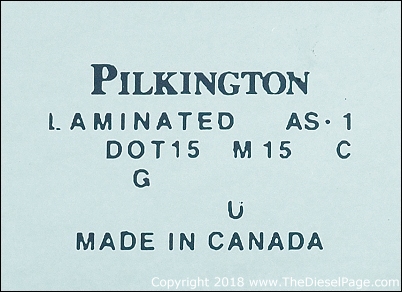 The auto glass shop owner finally offered to install a genuine OEM windshield, so I agreed. This image shows the brand and manufacturer logo information. Also, notice the DOT designation - that was missing from the two imported windshields that disappointed me. I love Canadian companies. They take pride in the products they produce and feel a sense of responsibility to the end-users of the products that bear their name. This Pilkington windshield is perfect. This image was taken with a sheet of white typing paper laying on the dash. The logo is located at the bottom/center of the windshield. Notice the DOT code.
What do the codes mean?
Name of Auto Manufacturer: (i.e. GM) Not always present. Never present on supposed "OEM Quality" replacement glass. 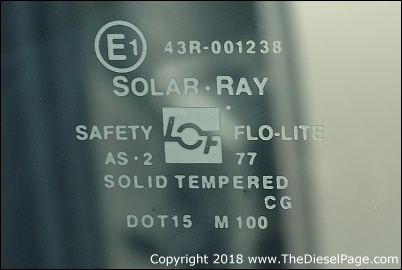 This photo shows the logo information used on the original front driver's side door glass used in my 2001 GMC 2500HD. I was sitting in the truck a couple of years ago waiting for my wife. While waiting I had the window down about halfway. The late morning summer sun was streaming in through that half open window and hitting my bare left arm. There was a big difference in felt heat on the part of my arm that was shadowed by the door glass. The "Solar Ray" glass was reducing the heat effect of the sunlight passing through it by at least 50%. What this means is that aside from the visual color of the tint, any replacement glass should have the same light transmission and thermal properties. That's what I would want. Notice the DOT code. 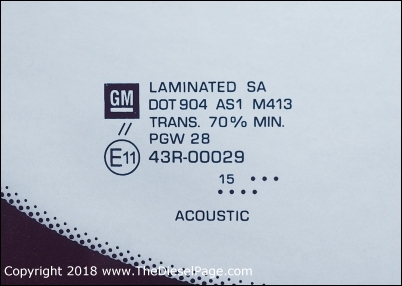 This photo shows the glass logo information placed on the windshield used in a new Chevrolet Malibu. This is a Pittsburg Glass Works windshield. Aside from all of the qualities coded in this photo, the word "Acoustic" is also included. Who knew glass could be formulated or manufactured in ways to help control sound? Would you want an aftermarket windshield? I wouldn't. Notice the DOT code. 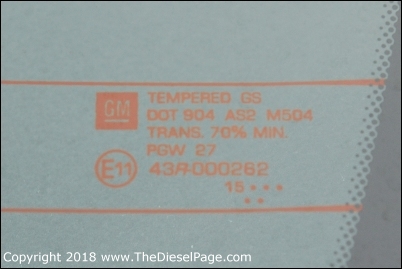 This photo shows the logo information placed on the rear window in the same Chevrolet Malibu. The rear glass was also manufactured by Pittsburg Glass Works. Notice the DOT code. "OEM vs. OEM quality" The article shown on page 18 of this PDF, entitled: OEM vs. Aftermarket Glass: What You Need to Know is a fair discussion about quality, function and safety issues where automotive glass is concerned. Why is any of this important? Excellent question! Some would argue that saving money is the most important factor when looking for a replacement windshield. I disagree. The Federal government regulates the safety and durability (including chip resistance) requirements for automotive glass. That's why the DOT designation is so important. Installers also share in a legal responsibility to protect consumers. After all, they are supposed to be the auto glass experts. Installing poor quality glass in an effort to save a few bucks may not be the best choice. A fully informed consumer should be a part of the decision making process. Bottom line: Ask your glass installer what brand of glass he's planning to install in your truck. The Diesel Page - March 2018 What's New: | Feature Articles: | Product Reviews: | Member's Area: Join Us: | Duramax Diesel Page: | Advertisers: | Classified Ads: | Books:
Send e-mail to: turbo@TheDieselPage.com |

